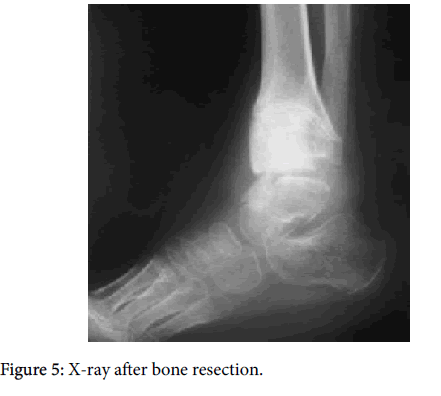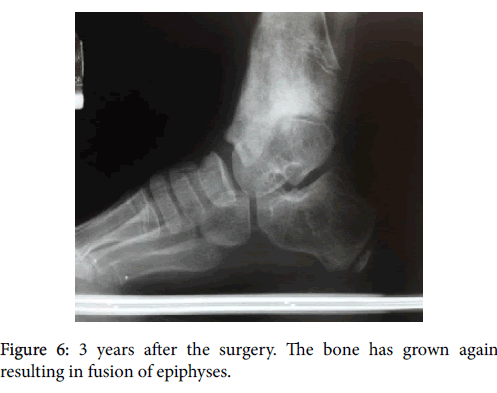Case Report Open Access
Case Report: Trevor Disease in a Child’s Ankle: 3 Years of Postoperative Follow-up
Rui Barroco, Thiago Rocha Protta*, Lara dos Santos, Marcelo Petrilli and Osvaldo NascimentoDepartment of Orthopedic Surgery, Faculdade de Medicina do ABC, Brazil
- *Corresponding Author:
- Thiago Rocha Protta
Department of Orthopedic Surgery
Faculdade de Medicina do ABC, Brazil
Tel: +5511973710562
E-mail: thiagofmj@yahoo.com.br
Received date: June 08, 2016; Accepted date: December 20, 2016; Published date: December 27, 2016
Citation: Barroco R, Protta TR, Santos LD, Petrilli M, Nascimento O (2017) Case Report: Trevor Disease in a Child’s Ankle: 3 Years of Postoperative Follow-up. Clin Res Foot Ankle 5:221. doi: 10.4172/2329-910X.1000221
Copyright: © 2016 Barroco R, et al. This is an open-access article distributed under the terms of the Creative Commons Attribution License, which permits unrestricted use, distribution, and reproduction in any medium, provided the original author and source are credited.
Visit for more related articles at Clinical Research on Foot & Ankle
Introduction
Hemimelic epiphyseal dysplasia, also known as Trevor disease, is a rare, nonhereditary epiphyseal disease of unknown etiology that simulates chondromatosis in the synovial joints [1]. The most commonly involved sites are the distal femur, proximal tibia, talus, and navicular. The complaint is usually related to deformity and limited range of motion from the affected joint. The disease stops when skeletal maturity is completed; however, deformities will persist [2].
The treatment should be customized depending on the symptoms and functional limitations resulting from the deformities. Usually begins with analgesic physiotherapy and stretching. In cases where conservative treatment fails surgery becomes an option. The purpose of surgery is to resect the ossification leading to a reduction in functional limitations [1,2].
Case report
This case report is about a patient who came to our hospital in 2011, when he was 4 years old and complaining of progressive increase in right ankle volume with limited dorsiflexion of the right foot and difficulty in playing sports for the past year. A physical examination showed an equine (10°of restriction to achieve the neutral position), hard, and painless mass in the anterior region of the lateral ankle with a valgus deviation of 10° and mild claudication but without neurological change.
A radiography exam showed anterior and distal bone exostosis from the tibial epiphysis region to the upper cavity of the talus neck. Tomography and magnetic resonance imaging (MRI) helped us to evaluate the physeal plate that was merged into the lateral anterior region. The volume of the mass was also measured; its dimensions were 3.2 × 3.4 × 2.5 cm.
Treatment was started with physical therapy; however, after eight months of evolution, the patient’s symptoms had not improved, and the mass had increased (Figure 1). Thus, the exams were updated, finding that the exostosis had grown significantly to include the medial anterior region; moreover, there was medial remodeling of the fibular metaphysis and a valgus at the head of the talus (Figure 2).
Due to the failure of the conservative treatment, we chose surgery and resection of the bone exostosis for the next treatment. Through dual medial and anterolateral incisions, it was possible to resect the mass, and a plantigrade foot was achieved (Figures 3-5).
In the postoperative follow-up, we prescribed an orthopedic boot to reinforce the plantar arch and the use of night orthotics to keep the foot in a neutral position.
Currently, the patient is 8 years old and is in the third year of postoperative care. He has kept the gains achieved with surgical treatment without walking complaints and with minimum pain.
Radiographs show new growth of exostosis leading to anterior fusion between the tibia and the talus (Figure 6); in addition, there is a secondary inclination of the distal physis from anterior fusion and a subsequent growth in the posterior part.
Discussion
Trevor’s disease is a rare condition that affects 1:1,000,000 people and has a male-to-female ratio of 3:1; approximately 250 cases have been described in the literature since 1957. The age of diagnosis is usually between 2 and 14 years [3,5-7].
The clinical picture begins with a painless enlargement of the articular region affected. The evolution of the disease involves increased bone mass, limited range of motion, discrepancies between digits, muscular atrophy, and pain [6].
Diagnosis is made through X-rays showing an asymmetrical epiphyseal growth; biopsy is required only in atypical cases [8].
The radiograph shows a mass with foci of ossification around the epiphysis. In later stages, this mass may merge with the epiphysis [3].
CT helps to clarify the dimensions and shape of the bone mass; MRI helps to assess cartilage and soft tissue involvement [8].
Treatment is based on symptoms and is conservatively indicated in most cases. Surgery is indicated when the joint blockage leads the patient to have pain and functional impairment. Even after the removal of bone mass, recurrence is frequent, and further resections may be required [2-4].
A review of the literature found that excision results are usually good and that two-thirds obtained total gain of range of motion, however, 15% of patients develop early osteoarthritis, and 7.7% will require ankle arthrodesis in the future. No cases have progressed to malignancy [4].
The differential diagnosis is made with synovial chondromatosis, multiple epiphyseal dysplasia, and osteosarcoma. Histopathologically, it is not possible to distinguish Trevor’s disease from osteochondroma [1].
The goal of surgery is to remove joint incongruence, making the joint smooth and without impingement due to bone growth. Until skeletal maturity is achieved, further surgeries may be required [2,4,9].
References
- Gokkus K, Aydin AT, Uyan A, Cengiz M (2011) Dysplasia epiphysealis hemimelica of the ankle joint: a case report. J Orthop Surg 19: 254-256.
- Sadeghifar AR, Heshmati AA (2014) Dysplasia Epiphysealis Hemimelica (Trevor Syndrome) of Talus in a 21-Year Old Woman; Case Report. Arch BoneJt Sur2:66-68.
- Azzoni R (2009) Dysplasia epiphysealis hemimelica of the talus. J OrthopTraumato10:43-46.
- Arealis G, Nikolaou VS, Lacon A, Ashwood N, Hayward K et al. (2014) Trevor’s Disease: A Literature Review regarding Classification, Treatment, and Prognosis apropos of a Case. Case Reports in Orthopedics,pp: 1-8.
- Bhosale SK, Dholakia DB, Sheth BA, Srivastava SK (2005) Dysplasia epiphysealis hemimelica of the talus: two case reports. J Orthop Surg 13: 79-82.
- Silveira RB, Lopes FAR, Reis ALB, Granzotto E, Oliveira AGD (2013)Dysplasia epiphysealis hemimelica (Trevor-Fairbank disease): case report. Radiologia Brasileira 46: 59-60.
- Gopinathan NR, Sudesh P, Sament R, Viswanathan VK (2013) Acutely presenting kissing lesions of the ankle: an atypical Trevor’s disease and literature review of other unusual presentations of the disease. BMJ Case Rep.
- Vogel T, Skuban T, Kirchhoff C, Baur-Melnyk A, Siegert S et al. (2009) Dysplasia epiphysealis hemimelica of the distal ulna: a case report and review of the literature. Eur JMed Res 14:272-276.
- Bakerman K, Merv L, Lou L (2005) Dysplasia epiphysealis hemimelica of the ankle in children.Can J Surg48: 66-68.
Relevant Topics
Recommended Journals
Article Tools
Article Usage
- Total views: 5586
- [From(publication date):
March-2017 - Jul 06, 2025] - Breakdown by view type
- HTML page views : 4597
- PDF downloads : 989






